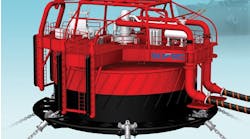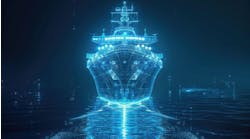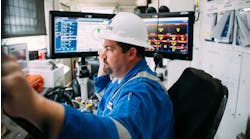Acquisition of Canyon Offshore hints at future direction of Cal Dive
By Jennifer Pallanich Hull, News Editor
Canyon Offshore's focus on deepwater construction and the use of remotely operated vehicles (ROVs) was an ideal match for vertical integration with long-standing customer Cal Dive Internat-ional. With a backlog of deepwater installation projects on its books, Cal Dive needs a reliable source of ROV support.
"One of the attractions of the acquisition was that we knew each other very well," said Cal Dive President and COO Martin Ferron.
The drivers
The two Houston-based companies are slated for some major upcoming projects, one of which they will be working on together while the integration is underway. Cal Dive is scheduled to install flowline connectors, jumpers, and fly-in leads for Shell's giant Nakika project on Mississippi Canyon Block 474 in the Gulf of Mexico. The ROVs for this project will be provided by Canyon.
The two companies will begin work on this installation in 7,000 ft water depth in 3Q 2002. Cal Dive said the ongoing trend toward deeper water construction played a major role in the decision to buy an ROV company.
"As marine construction support in the Gulf of Mexico moves to deeper and deeper waters, ROV systems will play an increasingly important role," Cal Dive CEO Owen Kratz said at the time of the purchase.
The deal
Under the deal, Cal Dive bought 85% of Canyon Offshore and will purchase the remaining 15% over the next three years for $66 million to $74 million. Integration of the two companies, which will not be complete until Cal Dive purchases the remaining 15% of Canyon, is going well. "Their entrepreneurial culture should fit very well with ours," Ferron said. Corporate culture is a big consideration for both companies. Cal Dive is not just buying ROV equipment, but the talent to operate it. Cal Dive added Canyon Offshore's 800 employees to its stable of 180 onshore staff and 1,200 offshore workers. "It's important for us to increase the depth of our personnel pool," Ferron said.
The purchase also ensured a reliable source of equipment for Cal Dive by adding the Quest line of ROVs.
Cal Dive's new construction vessel, the Q4000, was headed for work off Brazil and Trinidad after a scheduled christening in early April. The plan is for this $150 million ultra-deepwater, multi-service vessel to perform a variety of work to showcase its versatility, Ferron said. The vessel is designed to perform a broad range of functions, including well completion and tree setting, template and module installation, intra-field flowline and umbilical lay, well intervention, steel J-lay or reel-lay, and field decommissioning. It can also perform life-of-field support, repair, and maintenance in 10,000 ft water depths. This one-of-a-kind rig is a hybrid of a column stabilized semisubmersible design without the lower hull cross bracing. This improves the vessel's dynamic positioning performance and eliminates the possibility of the bracing interfering with positioning large equipment under the vessel for installation.
"We have about 90 days booked from when she finishes sea trials," Ferron said. "It's not really a matter of whether the Q4000 becomes fully utilized, but a matter of when."
In addition to the Q4000, Cal Dive is bringing other vessels into service. The Eclipse, acquired late last year, finished sea trials in March, while the Intrepid is still in the yard. The vessel was delayed because Cal Dive underestimated the difficulty of the electrical component of the Intrepid's upgrade, Ferron said.
New horizons
The purchase of Canyon brings with it experience in an area outside oil and gas. Cal Dive hopes to benefit from the lucrative telecommunications market, which accounts for 60% of the profits Canyon Offshore generated in 2001. While it is a different industry, the installation fundamentals are the same. It is basically submarine cable burial work. Ferron said he has no doubt that the work generated by the telecom industry will continue to grow. In fact, he said, telecommunications is an area ready for a change in structure, which might later enable a duo like Cal Dive and Canyon Offshore to work together in new ways, Ferron said.
"As a company, we like to find where the value is and tap into it," he said.
Aside from market diversity, Canyon also offered geographic diversity. Of particular interest to Cal Dive was Canyon Offshore's presence in the offshore Asia Pacific, North Sea, and European markets. With the acquisition, Cal Dive can take advantage of this existing presence to move into a new area without having to set up new offices. "These are just spin-off benefits, really," Ferron said.
New ventures
Cal Dive, through its Energy Resource Technology (ERT) subsidiary, took the bold step of partnering on the 120 MMbbl Gunnison Field, set for production in early 2004. Operator Kerr-McGee holds 50% interest in the Gulf of Mexico field, Nexen Petroleum holds 30%, and Cal Dive International holds 20%.
Jim Nelson, Cal Dive Vice Chairman, said the decision to partner on Gunnison stemmed from the company's desire in the late 1990s to expand into deepwater.
"We understand the reservoir," he said, adding Cal Dive approached Kerr-McGee regarding partnership possibilities. When Cal Dive's ERT staff studied the prospects Kerr-McGee suggested, they "liked Gunnison the best," he said. "They assigned it a one-in-eight chance of success."
Cal Dive committed itself to ante up $15 million to get into Gunnison, but investors behind $13 million pulled out late in the game. Nelson said Kratz felt so strongly about the prospect that he put his own money into it. Several others in the company added $1 million to the pot, enabling the company to nab a percentage of the field. In addition to being a promising field, Gunnison had the added bonus, from the standpoint of a construction company, of being in an isolated area of the Gulf. Once it was brought on line, the thinking was that Gunnison would become a hub for production from other fields in the area, potentially drumming up more work for Cal Dive, Ferron said. "We're looking to generate a lot of construction," he said.
Though the company is willing to take a stake in such fields and to perform a variety of installation and construction activities, it draws the line at exploration drilling. "(We) don't address this, and we never will," Ferron said.
The Canyon acquisition highlights the importance of equipment availability in the fast-paced offshore construction business. While there were various advantages to the deal, the key, clearly, was access to a fleet of ROVs and the crews to man them. It is these assets that will allow construction companies to expand their operations as production in remote deepwater locations increases.





